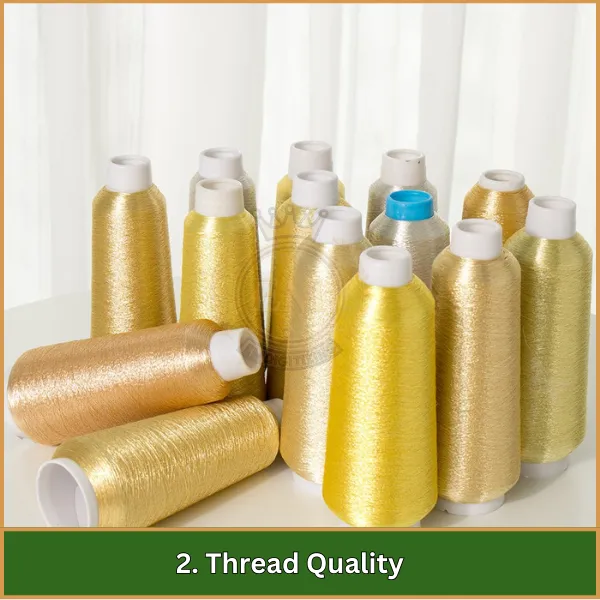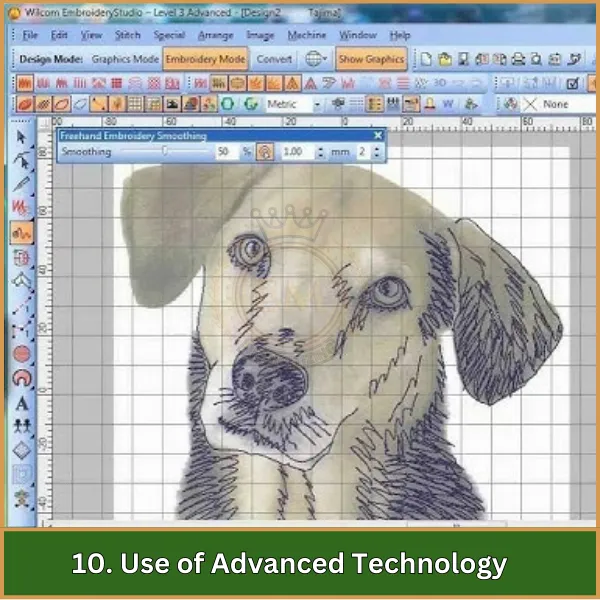Das Erreichen makellose Stickereien kann sich schwierig anfühlen, Ein paar einfache Anpassungen können jedoch den Unterschied ausmachen. Indem Sie sich auf bestimmte Faktoren konzentrieren, Sie können die Qualität der Stickerei verbessern und Ergebnisse auf professioneller Ebene produzieren.
In diesem Artikel, Wir werden die Schlüsselfaktoren untersuchen, die zu einer besseren Stickerei beitragen, Von der richtigen Materialauswahl bis zur Beherrschung Ihrer Maschineneinstellungen, Stellen Sie sicher, dass Ihre Projekte jedes Mal wunderschön ausgehen.

12 Wichtige Faktoren, die die Stickqualität verbessern
Faktoren zur Verbesserung der Stickqualität
Verbesserung der Qualität von Maschinenstickerei beinhaltet die Aufmerksamkeit auf mehrere Schlüsselfaktoren, die das Endergebnis stark beeinflussen können.
- Nadelschärfe
- Fadenqualität
- Oberfadenspannung
- Niedrigere Fadenspannung
- Backpapierdicke
- Maschinenqualität
- Spannung umrahmen
- Einhaltung von Anweisungen
- Stoffqualität
- Einsatz fortschrittlicher Technologie
- Richtige Reifengröße
- Stabilisatorentfernungstechnik
Jetzt, let’;S Sehen Sie sich an, wie jeder dieser Faktoren dazu beiträgt, die Qualität Ihrer Stickerei zu verbessern.
1. Nadelschärfe
Eine scharfe Nadel ist entscheidend für saubere und präzise Nähte, Und es ist einer der Schlüsselfaktoren, wie die Qualität der Maschinenstickerei verbessert werden kann. Stumpfnadeln können zu Franien und ungleichmäßigen Stichen führen, was zu einem schlechten Abgang führt. Regelmäßig wechselnde Nadeln basierend auf der Art des verwendeten Stoffes gewährleistet eine optimale Leistung.
Die korrekte Nadelgröße für die Kombination aus Faden und Stoff ist ebenfalls wichtig. Zum Beispiel, Eine größere Nadel wird für dickere Fäden und Stoffe benötigt, Während eine kleinere Nadel für feinere Materialien geeignet ist.
2. Fadenqualität

Hochwertige Fäden sind für Haltbarkeit und Aussehen von wesentlicher Bedeutung. Sie sollten stark sein, farbecht, und für den spezifischen Stoff geeignet. Fäden in schlechter Qualität können leicht brechen und halten ihre Farbe möglicherweise nicht im Laufe der Zeit, das allgemeine Aussehen der Stickerei beeinflussen.
Die Verwendung des entsprechenden Fadentyps für den Stoff ist entscheidend, um die Stickqualität zu verbessern. Zum Beispiel, Polyesterfäden sind für die meisten Stoffe geeignet, Während Rayon -Fäden ein glänzendes Finish bieten und häufig für empfindliche Materialien verwendet werden.
3. Oberfadenspannung

Die richtige obere Gewindespannung ist für ausgewogene Nähte von entscheidender Bedeutung. Wenn die Spannung zu eng ist, Der Thread kann brechen; if it’;s zu locker, Die Stiche können schlampig erscheinen. Das Einstellen der Spannung entsprechend dem Stoff und dem Gewindeart trägt dazu bei, eine glatte Finish zu erreichen.
Die Spannung sollte eng genug sein, um Schleifen an der Unterseite des Stoffes zu verhindern und gleichzeitig den Faden frei durch die Nadel zu bewegen.
4. Niedrigere Fadenspannung

Ähnlich wie die obere Spannung, Eine niedrigere Gewindespannung muss korrekt eingestellt werden, um das gleichmäßige Nähen zu gewährleisten. Ein Ungleichgewicht kann zu Problemen wie Fadenbündelung oder losen Stichen an der Unterseite des Stoffes führen.
Die Feinabstimmung beider Spannungen ist der Schlüssel, um die Qualität der Stickerei zu verbessern. Die untere Gewindespannung sollte etwas enger sein als die obere Gewindespannung, um eine konsistente Stichbildung beizubehalten.
5. Backpapierdicke
Das Hintergrundmaterial unterstützt den Stoff während der Stickerei. Die Auswahl der richtigen Dicke verhindert Verzerrungen und stellt sicher, dass die Stiche ihre Form halten. Eine zu dünne Unterstützung kann zum Klopfen führen, während eine zu dicke Unterstützung durch den Stoff sichtbar sein kann.
Die Art des Unterhaltungsmaterials sollte ebenfalls berücksichtigt werden, Da einige besser für bestimmte Stoffe geeignet sind. Zum Beispiel, Cut-Away-Unterstützung ist ideal für Strickstoffe, während die Tränenrücken für gewebte Materialien gut geeignet sind.
6. Maschinenqualität
Die Qualität der Stickmaschine spielt eine wichtige Rolle im Endprodukt. High-End-Maschinen bieten eine bessere Präzision, Weitere Funktionen, und verbesserte Stichqualität.
Das Investieren in eine zuverlässige Maschine kann das Gesamterlebnis der Stickerei verbessern. Routinewartung, wie Reinigen und Ölen der Maschine, Hilft einer optimalen Leistung und erweitert die Lebensdauer.
7. Spannung umrahmen
Richtig, den Stoff richtig umrahnen. Lose Stoff kann zu ungleichmäßigen Nähten und Verzerrungen führen. Wenn Sie den richtigen Reifen verwenden und sicherstellen, dass der Stoff sicher gehalten wird, kann diese Probleme verhindern.
Der Stoff sollte fest genug sein, um zu verhindern, aber nicht so eng, dass er das Design verzerrt oder das Material beschädigt.
8. Einhaltung von Anweisungen
Following the manufacturer’;s Anweisungen sowohl für Maschine als auch für Materialien sind entscheidend. Dies beinhaltet Einstellungen für die Spannung, Geschwindigkeit, und Art von Nadel und Faden. Wenn Sie diese Richtlinien einhalten. Das Experimentieren mit verschiedenen Einstellungen und Techniken kann auch dazu beitragen, die Fähigkeiten der Stickereien zu verbessern und bessere Ergebnisse zu erzielen.
9. Stoffqualität
Die Art und Qualität des Stoffes verbessern die Stickqualität erheblich. Stoffe, die zu dehnbar oder zu dick sind, können Komplikationen verursachen. Die Auswahl des richtigen Stoffes, der den Design und den Fadenstyp ergänzt. Vor dem Stoff zum Entfernen von Größen oder Oberflächen zu verbessern, kann auch dazu beitragen, die Stichqualität zu verbessern und nach dem Sticken Schrumpfung zu verhindern.
10. Einsatz fortschrittlicher Technologie

Einbeziehung von Technologien wie z. Digitalisierungssoftware und automatisierte Maschinen können verbessern, wie die Bildqualität der Maschinenstickerei verbessert werden kann. Fortgeschrittene Funktionen ermöglichen kompliziertere Designs und präzises Nähen. Wenn Sie mit der neuesten Technologie aktualisiert bleiben, können Sie die Effizienz und die Produktionsqualität verbessern.
Die Digitalisierung von Software ermöglicht die Erstellung komplexer Designs, die leicht auf die Stickmaschine übertragen werden können, während automatisierte Maschinen eine konsistente Stichqualität und Geschwindigkeit sorgen.
11. Richtige Reifengröße

Die korrekte Reifengröße für Ihren Stoff und Ihr Design ist entscheidend. Ein zu großer Reifen kann dazu führen, dass sich der Stoff während des Stickprozesses verschiebt, führt zu Fehlausrichtung oder Verzerrung im Design. Ein ordnungsgemäß ausgestatteter Reifen stellt sicher, dass der Stoff sicher an Ort und Stelle bleibt, was zu genaueren und konsequenteren Nähten führt.
12. Stabilisatorentfernungstechnik
Die Art und Weise, wie Sie den Stabilisator nach der Stickerei entfernen, kann das endgültige Erscheinungsbild des Designs beeinflussen. Eine unsachgemäße Entfernung kann dazu führen, dass sich der Stoff dehnt oder verzerrt. It’;s essential to follow the manufacturer’;s Anweisungen zum Entfernen des Stabilisators - ob abschneiden, reißen, oder sich auflösen - die Integrität von beiden aufrechtzuerhalten Stoff für die Stickerei.
Einpacken
Um die Stickqualität wirklich zu verbessern, a Gut digitiertes Design ist wesentlich. Auch mit den besten Techniken und Geräten, Eine schlechte Digitalisierung kann Ihre Projekte zurückhalten.
Bevor wir zum Abschluss kommen, Wenn Sie Digitalisierungsdienste benötigen, Nehmen Sie gerne Kontakt mit uns auf. Wir bieten erschwingliche Digitalisierungsdienste mit garantierten Qualitätsergebnissen. We’;erneut anbieten 50% auf den Weg zu neuen Kunden, so grab this amazing deal before it’;Es ist zu spät!
Vielen Dank, dass Sie diesen Artikel gelesen haben. Wenn es Ihnen gefallen hat, Bitte teilt es. You’;Sie sind auf dem Weg, ein Stickprofi zu werden!
Häufig gestellte Fragen
Digitalisierung in Stickerei ist der Prozess, Kunstwerke in eine digitale Datei umzuwandeln, die eine Stickmaschine lesen kann. Gute Digitalisierung sorgt glatt, Genaue Nähte, die die Qualität der endgültigen Stickerei erheblich verbessert.
Hochwertiger Faden reduziert die Chancen des Brechens und Ausfransens, was zu glatteren und lebendigeren Stickereien führt. Schlechte Fadenqualität kann zu ungleichmäßigen Nähten und einem weniger professionellen Finish führen.
Ein Stabilisator hält den Stoff während der Stickerei stabil, verhindern, dass es sich dehnt oder verschiebt. Dies sorgt für sauber, precise stitching and helps maintain the design’;S Form und Qualität.
Komplexe Designs mit komplizierten Details können für das Sticken schwierig sein und erfordern möglicherweise fortschrittlichere Techniken und bessere Digitalisierungen. Einfachere Designs sind im Allgemeinen einfacher mit höherer Qualität auszuführen.
